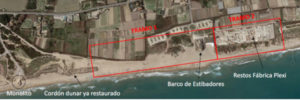
Valenciaport will condition an area of 800 metres between the old Plexi factory, the sports facilities already dismantled and the restored part near the “bunker” of El Saler.
A line of dunes will be created, protected by biodegradable palisades, to prevent flooding and loss of beach material.
The work will be completed with the repopulation of plant species in accordance with the guidelines of the Devesa-Albufera Service.
The Port Authority of Valencia (PAV) will invest more than 600,000 euros in this action.
The Port has been able to undertake this project after obtaining the approval of the Coast Demarcation.
The Port Authority of Valencia (PAV) is going to restore the dune system of La Creu de El Saler beach in order to favour the natural regeneration of the beach and to enhance a landscape of great ecological value. Work will be carried out on an area of 800 metres of coastline in which the dune system will be reintegrated by forming new cordons, fixing the dunes with a system of biodegradable palisades, planting species typical of these ecosystems and protecting them by cordoning off and signposting the area.
Specifically, this project is located on La Creu beach, which is bounded to the north by the ruins of the old “Plexi” factory and to the south by the already restored dunes near the monolith or bunker of El Saler (former artillery casemate). This land had sports infrastructures, a public school and the factory, all of which have now been demolished. The initiative developed by the PAV will serve, on the one hand, to contain storms and prevent loss of beach material and, on the other hand, to naturalise the surface after the dismantling of these infrastructures.
Habitat protection
The dunes on La Creu beach will be created with 39,000 m3 of sand from the southern area of Cabanyal beach (which will be regenerated in less than a year). The average height of the dunes will be between 2 and 4.5 metres above sea level, depending on the terrain. The dunes will be fixed with palisades made of borró (Spartina versicolor) and reinforced with cane (Arundo donax), which will retain the accumulated sand and allow any new sand that may arrive transported by the wind to be captured.
The action was programmed several years ago by the Port Authority but was pending the approval of the Coast Demarcation, the competent authority for action on the Valencian coast.
The work now being undertaken by the Port aims to preserve and enhance natural habitats and wildlife. According to the Devesa-Albufera service of Valencia City Council, there are three habitats of Community interest in this area, which include the plants Ammophila arenaria, Crucianellion maritimae and a forest of Pinus pinea. In this sense, the restoration of the vegetation cover of the dunes will be carried out in accordance with the guidelines of the Devesa-Albufera Service using the modular method of repopulation in which the composition and proportion of plant species varies according to the part of the dune. Thus, barron (Ammophila arenaria) and sea grass (Elymus farctus) will be used to facilitate the fixation of the dunes, which will be accompanied by other species. In total, 16 varieties will be used and a total of 38,111 plants will be planted.
In addition, special attention will be paid to the protection and care of the area where the protected Chorlitejo patinegro nests. Thus, for example, the execution of these works will take into account the breeding season of this bird and the creation of dunes in the nesting sites of this protected species will be ruled out in order to conserve its habitat.
Commitment to our beaches
The tender documents for this work have a budget of 628,703 euros and a completion period of four months. The reconstruction of the dune system will help to maintain the coastal sedimentary balance, while at the same time creating an essential sand reserve. In addition to restoring the dunes, this project, which is part of the Strategy for the Defence of the Maritime-Terrestrial Public Domain, will favour the recovery of the fauna associated with this ecosystem and will enable the recreational and educational use of the dune system in the town to be organised.
This action on La Creu beach is part of the compliance with the Environmental Impact Statement (EIS) for the access channel to the inner dock of the Port of Valencia for the America’s Cup 2007 and the Port enlargement project.

